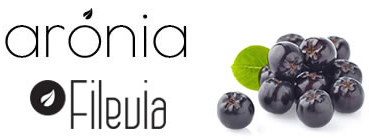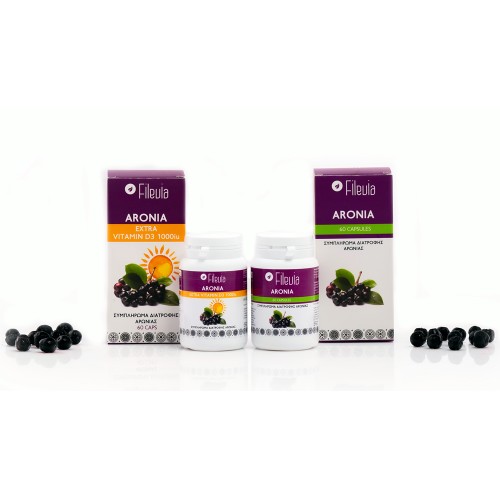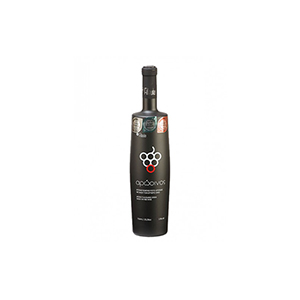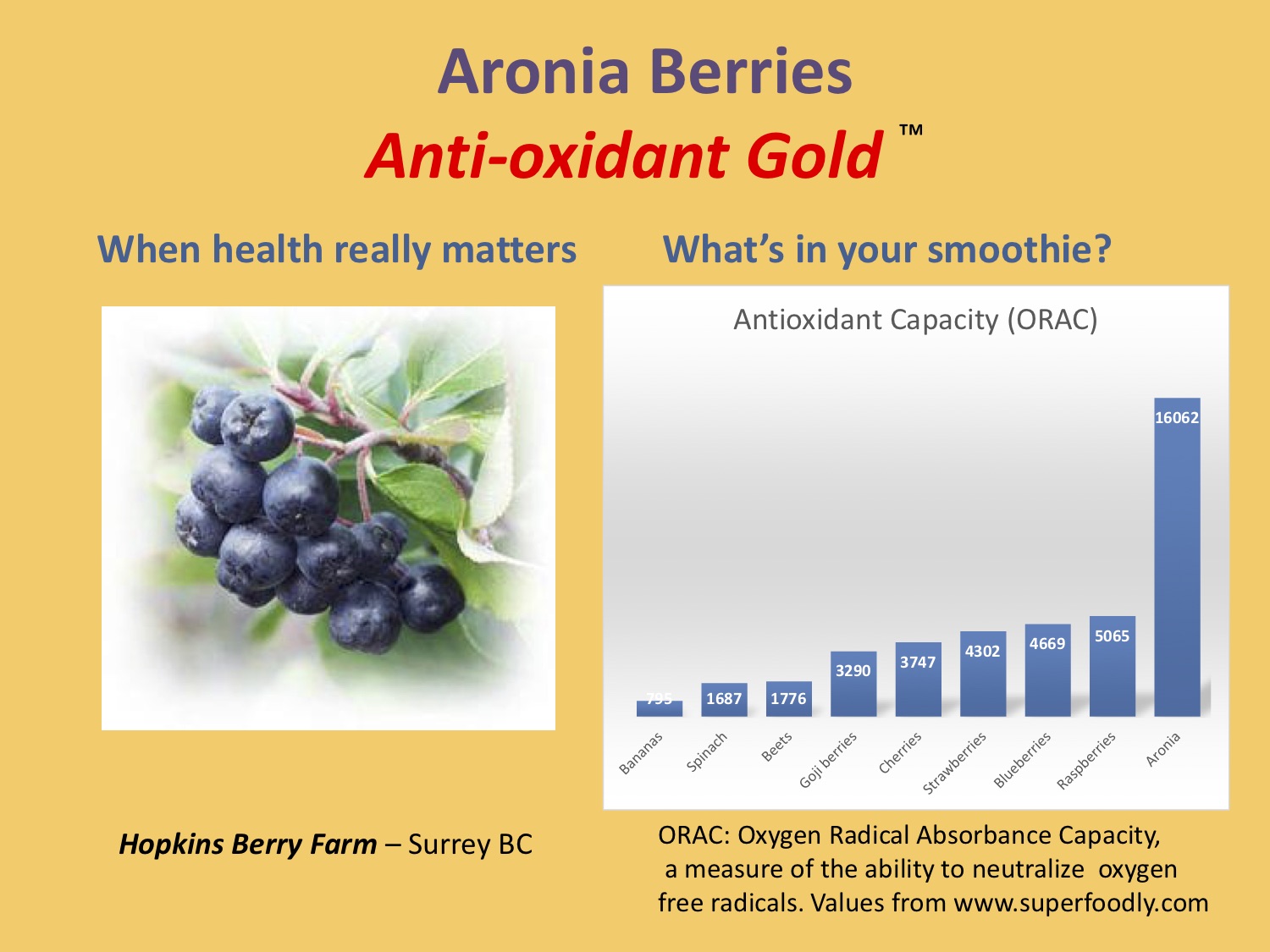Aronia: THE MIRACLE OF NATURE
The properties of a superfood
Aroniamelanocarpa belongs to the rosaceae family and is widespread. It originates from Northeastern America and the systematic cultivation of the plant in Europe began with World War II, after it was recognized as a medicinal plant. It is a deciduous shrub with a height that reaches 3m. The fruit is small, black and is usually round or oval. It blooms from mid-May and its fruit ripens at the end of summer.
H aronia in the top places in the International scale of medicinal plants.
Today, the effects of a diet rich in aronia are being investigated and the results are presented below.
Phytochemical composition :
The fruits are full of flavonoids (epicatechin, quercetin < trace elements and phenolic compounds (caffeic acid derivatives), and anthocyanins (3- cyanidine galactosite , malvidine, petunidine, pelargonidine and peonidine). The anthocyanin content is one of the highest of any known plant (several times higher than cranberry juice). Aronia fruits are rich in procyanidins (tannins), anthocyanins and phenolic acids. The fruit is isolated from amygdalin, a cyanogenic glucoside that is responsible for the bitter almond odor of fresh fruit.
Action against atherosclerosis and heart disease:
Anthocyanins and other polyphenols from aronia can potentially be used to combat oxidative stress in order to prevent cardiovascular disease. Antioxidants are useful in protecting endothelial function, promoting vascular relaxation and improving platelet aggregation. The use of moderate doses of statins in combination with natural antioxidants may represent an alternative therapeutic approach.
Anti-cancer action:
Animal studies have shown that chokeberry anthocyanins can affect genotoxicity and act as anti-mutagens.
Neuroprotective action :
Extracts rich in antioxidants, such as those of aronia, seem to be effective in reversing possible age-related deficiencies related to neuronal and behavioral parameters.
>
Action < b> for eye health :
Medicinal decoctions from the fruits and leaves have been used to help people maintain their visual acuity. Therefore, a diet rich in chokeberries is recommended for this purpose.
Action < b> against diabetes:
Eating a low-fat, high-antioxidant diet reduces the risk of obesity and insulin resistance. Antioxidants protect pancreatic beta cells from oxidative stress caused by glucose. Some studies show that anthocyanins stimulate insulin secretion. Chlorogenic acid (found in chokeberries) slows down the absorption of carbohydrates by inhibiting intestinal glucose transport. Regular intake of chlorogenic acid can help prevent or delay the onset of diabetes.
Digestive actionof problems :
According to traditional medicine, both diarrhea and constipation can be treated by eating fruits (blueberries, blackberries, and aronia). Recent studies confirm that the tannins contained help reduce inflammation of the digestive tract.
Anti-inflammatory action:
Results from many studies show the anti-inflammatory properties of anthocyanins. It is recommended that patients suffering from arthritis and intestinal pain follow a diet that includes eating fruits rich in anthocyanins.
It is the only fruit that has the ability to remove heavy metals from the body and reduce blood clots.
The majority of the beneficial properties of its fruits are due to the high concentration of polyphenolic compounds (flavonoids, anthocyanin and tannin) that disinfect the blood, remove toxic substances from the body, promote the healing of wounds, reduce inflammation, improve the elasticity of blood vessels and prevent heart attack.
Their content of flavonoids, natural antioxidants, vitamin P is one of the highest of all fruits.
In addition, chokeberries are sources of provitamin A (β carotene) and vitamins B2, B6, B9, C, E, K.
Contains radium, molybdenum, boron and iodine that are rarely found in plants, as well as pectin in very high concentrations that helps absorb and protect organisms from radioactivity.
>
For this reason in Eastern Europe and Russia the aronia fruit is given to nuclear workers and cosmonauts, before and after their space missions.
Aronia contains 277 counted antioxidants, more than any other berries, citrus fruits, vegetables, cereals and spices. Fresh fruit has the highest antioxidant activity of all fruits measured by the ORAC scale.
ORAC Scale ( www.oracvalues.com ) < / strong>
Aronia 16,062 μ mol TE / 100 gr
Blueberry ( wild ) 9,621 μ mol TE / 100 gr
Cranberry 9,090 μ mol TE / 100 gr
Ροδάκινο 6,257 μ mol TE / 100 gr
Apple 5,500 μ mol TE / 100 gr
Raspberry ( red ) 5,065 μ mol TE / 100 gr
Blueberry 4,800 mol TE / 100 gr
Strawberry 4,302 μ mol TE / 100 gr
Cherry 3,747 μ mol TE / 100 gr
Pomegranate 2,860 μ mol TE / 100 gr
Goji 2,970 μ mol TE / 100 gr
Grape 2,389 μ mol TE / 100 gr
Avocado 1,922 μ mol TE / 100 gr
Apricot 1,110 μ mol TE / 100 gr
Banana 792 μ mol TE / 100 gr
Orange 726 μ mol TE / 100 gr
Pear 704 μ mol TE / 100 gr
Melon 319 μ mol TE / 100 gr
Watermelon 142 μ mol TE / 100 gr
Anthocyanin content
Aronia 1,480 mg / 100 gr
blueberry 558 mg / 100gr
red raspberry 365 mg / 100gr
κεράσια 350-400 mg / 100 <
acaiberry 320 mg /100gr
The juice is especially recommended for patients with cardiovascular disease who have high blood pressure.
Consumption of juice without added sugar prevents and enhances the treatment of diabetes (type II diabetes) (Simeonov et al, 2002).
Clinical trials have shown that consuming 50ml of juice 3 times a day for 2 months normalizes blood pressure and regulates blood glucose and triglyceride levels resulting in better function liver and gallbladder. (Kowalczyk et al. (2003) Kuźniakt et al. (2009)).
Aronia is suitable for consumption by athletes, especially for those who burden and strain their muscular system, the high content of polyphenols increase the vitality of the body by stimulating the regeneration of muscles and tissues promote the healing of muscle injuries.
It is beneficial for pregnant women, children, diabetics, prevents wrinkles, slows down the aging of the body and skin. Positive effects of aronia have been observed in hemostasis because it helps blood clotting and subsequent thrombus formation. (Sikora et al.2010).
As antioxidants are a key ingredient in cancer prevention and tumor reduction (colon, and breast), aronia provides strong natural protection, and relieves severe pain.
(Kedziersk et al., 2010).
The plant anthocyanins have a significant protective effect on gastric disorders such as ulcers and gastritis (Matsumoto et al. 2004). Aronia flavonoids also have a positive effect on patients suffer from multiple sclerosis (Broncel et al. 2010).
Important data emerged about the extract of chokeberry fruit and its action against oxidative stress. A positive effect was found in its inhibition, we must emphasize that oxidative stress causes various diseases such as obesity, ulcerative colitis, Alzheimer’s disease, Parkison disease and others. (www.healthmad.com and Harold Stewart, 2012).
Effective plant effects against pancreatitis were found in studies by Jankowski et al. (2000).
It can also improve your cholesterol and lipid levels, helping the body produce good cholesterol (Morosanu et al.2011). Aronia contains a large amount of carotene which protects cells from damage and eyes from cataracts.
It is also rich in flavonoid antioxidants such as lutein and Zea xanthine that filters out sunlight and thus protects the eyes from macular degeneration (ARMD) and ocular inflammation (uveitis).
Due to its higher content of kinic acid it has been shown to prevent urinary tract infections, such as E.coli (Escherichia coli bacterium).
Due to its high iodine content, it has important antiseptic properties helping to fight the flu.
References about the medicinal properties of aronia in the following link. :






